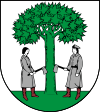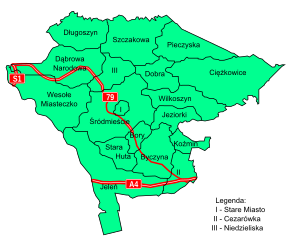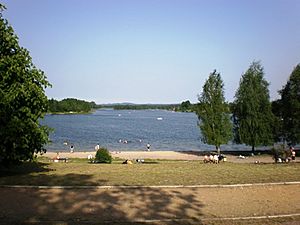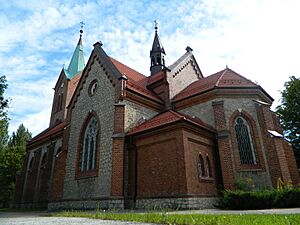Jaworzno facts for kids
Quick facts for kids
Jaworzno
|
|||
|---|---|---|---|
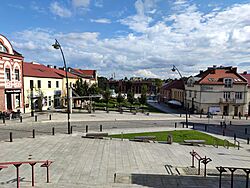
Rynek ("Market Square") in Jaworzno
|
|||
|
|||
| Motto(s):
Jaworzno – źródło energii.
Jaworzno – the source of energy |
|||
| Country | |||
| Voivodeship | |||
| County | county | ||
| Established | 1229 | ||
| City rights | 1901 | ||
| Area | |||
| • Total | 153 km2 (59 sq mi) | ||
| Population
(31 December 2021)
|
|||
| • Total | 89,350 |
||
| Time zone | UTC+1 (CET) | ||
| • Summer (DST) | UTC+2 (CEST) | ||
| Postal code |
43–600 to 43–618
|
||
| Area code(s) | +48 32 | ||
| Car plates | SJ | ||
| Website | http://www.jaworzno.pl/ | ||
Jaworzno is a city in southern Poland, located near Katowice. It sits on the Przemsza river, which flows into the Vistula. Jaworzno is part of the Silesian Voivodeship (a type of province) and has been since 1999. Before that, it was part of the Katowice Voivodeship.
The city is also part of a larger group of cities called the Katowice urban area, which has about 2.7 million people. The even bigger Katowice-Ostrava metropolitan area has around 5.3 million people. As of 2021, Jaworzno has a population of 89,350 people.
Contents
Geography of Jaworzno
Where is Jaworzno located?
Jaworzno is found in the Silesian Highlands. It is in the historical region of Lesser Poland. For a long time, it was connected to Kraków, which was Lesser Poland's capital.
The city's name comes from the jawor trees, also known as sycamore maples. These trees used to grow in large numbers in the area.
How is Jaworzno managed?
Jaworzno became part of the Silesian Voivodeship on January 1, 1999. Before that, it was part of the Katowice Voivodeship (from 1975 to 1998) and the Kraków Voivodeship before that.
Jaworzno is in the eastern part of one of Poland's largest city areas. This area grew a lot in the 1800s because of mining and metal industries. In 2006, Jaworzno and 14 nearby cities formed a group called the Upper Silesian Metropolitan Union. Jaworzno later left this group in 2016.
What is Jaworzno's climate like?
Jaworzno has a continental humid climate. This means it has warm summers and cold winters. The average temperature for the year is 8°C (46°F). In January, the average is -1.7°C (29°F), and in July, it's 17.7°C (64°F).
The city gets about 750 mm (30 inches) of rain each year. July is usually the rainiest month. Gentle winds, about 2 meters per second, blow from the west.
How do people travel in Jaworzno?
Jaworzno is a key spot for roads. The A4 motorway (part of European route E40) passes through it. The S1 expressway also connects to the A1 motorway (both part of European route E75). Other important roads include National road No. 79 and Voivodeship road 903.
Public transport in Jaworzno is run by PKM Jaworzno. This company was one of the first in Poland to use a special magnetic card, called the Jaworzno Urban Card, instead of paper tickets. PKM Jaworzno is known for being very modern. About 40% of its buses are electric vehicles.
What are the districts of Jaworzno?
Jaworzno is made up of several districts and housing estates. Some of them are:
- Bory
- Byczyna
- Cezarówka
- Ciężkowice
- Dąbrowa Narodowa
- Długoszyn
- Dobra
- Gigant
- Góra Piasku
- Jeleń
- Jeziorki
- Koźmin
- Niedzieliska
- Pieczyska
- Siłownia
- Podwale
- Stara Huta
- Stare Miasto (Old City)
- Szczakowa
- Śródmieście (Downtown)
- Wilkoszyn
- Wysoki Brzeg
- Osiedle Stałe
- Osiedle Awaryjne
- Osiedle Cegielniana
- Osiedle Chrząstówka
- Osiedle Energetyków
- Osiedle Gagarina
- Osiedle Górnicze
- Osiedle Kościuszki
- Osiedle Warpie
- Osiedle Leopold
- Osiedle Łubowiec
- Osiedle Pańska Góra
- Osiedle Podłęże
- Osiedle Skałka
- Osiedle Pszczelnik
- Osiedle Sobieski
History of Jaworzno
Early History and Growth
In the Middle Ages, an old fort was built on the Grodzisko hill. You can still find traces of it today. The first time Jaworzno was mentioned in writing was in the year 1229. By 1335, there was already a church dedicated to St. Wojciech.
Jaworzno started as a small village in western Lesser Poland. It was close to the bigger town of Chrzanów. From 1179, the nearby Przemsza river was the border between Lesser Poland and Silesia. This river also marked Poland's state border until 1922.
The area of Jaworzno was first controlled by the bishops of Kraków. After Austria took over Silesia in the late 1600s, several coal mines started to open near Jaworzno. In the 1700s, people found silver, lead, iron, and zinc here. In 1767, the very first coal mine in the Polish–Lithuanian Commonwealth opened in Szczakowa.
Jaworzno in the 19th and 20th Centuries
After the Partitions of Poland, Jaworzno became part of the Austrian Empire. From 1815 to 1846, it was part of the Free City of Krakow. In 1846, Austria took over the Free City. Jaworzno remained under Austrian rule until November 1918.
In the 1800s, Jaworzno became famous for the "Three Emperors' Corner". This was a spot where the borders of three big empires met: the German Empire, the Russian Empire, and Austria-Hungary. In 1847, a new railway line connected Jaworzno's Szczakowa district with Kraków and Prussian Upper Silesia.
Jaworzno quickly became an industrial center. A power plant opened in 1898. Jaworzno's coal mines produced a huge amount of coal. Many new factories were built in the late 1800s and early 1900s. Because of this growth, Emperor Franz Joseph I officially made Jaworzno a town on September 21, 1901.
After World War I in 1918, Poland became independent again and Jaworzno returned to Polish control.
World War II and Modern Times
In September 1939, World War II began when Germany invaded Poland. Jaworzno was taken over by Germany. During this time, the Germans set up several forced labor camps in the town. These included a prison/forced labor camp and subcamps of the Auschwitz concentration camp. People were forced to work in harsh conditions.
After the war, Jaworzno was returned to Poland. The former Nazi German subcamp of Auschwitz was turned into the Central Labour Camp Jaworzno. In the years after the war, Jaworzno grew as an important industrial city. Many people moved there to find work in coal mines, power plants, and factories. Several nearby villages also became part of Jaworzno, making the city's area about 152 square kilometers (59 sq mi). In 1975, the city became part of the Katowice Voivodeship. In 1999, Jaworzno was placed into the Silesian Voivodeship.
Environment in Jaworzno
A large part of Jaworzno, about 60%, is made up of green spaces, forests, and undeveloped land. Jaworzno has many important natural areas. These areas have different landscapes, plants, and animals.
Some of these special places include the Dolina Zabnika nature reserve, the Dobra Wilkoszyn landscape protection area, and the Sasanka natural monument. There is also the Grodzisko hill and the Sosina lake. Within Jaworzno, there are 41 plant species that are strictly protected and 11 that are partly protected.
Media in Jaworzno
Jaworzno has its own local media to keep people informed:
- Online News
- Jaw.pl
- Jaworzno.naszemiasto.pl
- Mojejaworzno.pl
- TV Station
- DlaCiebie.TV
- Newspapers
- Co Tydzień
- Tydzień w Jaworznie
- Extra
- Sokół Jaworznicki
Sport and Culture in Jaworzno
Jaworzno has many great sports facilities. The city's main arena, the Hala Widowiskowo-Sportowa, can hold 2,500 people. The Sosina water sports center is where the yearly Polish water-skiing championships take place.
Football Teams
- Szczakowianka Jaworzno – a football team that played in the 1st league in 2002/2003.
- GKS Victoria Jaworzno – Poland's oldest team for miners.
- The Puma Youth Academy (Akademia Los Puma) – a football team for younger players.
Notable People from Jaworzno
Many interesting people have come from Jaworzno:
- Shelomo Selinger (born 1924), a Polish-Jewish sculptor.
- Andrzej Stalmach (1942–2020), an athlete.
- Basia Trzetrzelewska (born 1954), a singer and songwriter.
- Bogdan Wołkowski (born 1957), a professional billiards player.
- Andrzej Karweta (1958–2010), a Polish Navy Admiral.
- Jan Urban (born 1962), a footballer.
- Wojciech Saługa (born 1969), an economist and politician.
- Paweł Sarna (born 1977), a poet.
- Grzegorz Proksa (born 1984), a boxer.
Twin Towns – Sister Cities
Jaworzno has special partnerships with other cities around the world. These are called twin towns:
 Hereford, England, United Kingdom
Hereford, England, United Kingdom Karviná, Czech Republic
Karviná, Czech Republic Szigethalom, Hungary
Szigethalom, Hungary Yiwu, China
Yiwu, China Berezan, Ukraine
Berezan, Ukraine
See also
 In Spanish: Jaworzno para niños
In Spanish: Jaworzno para niños



